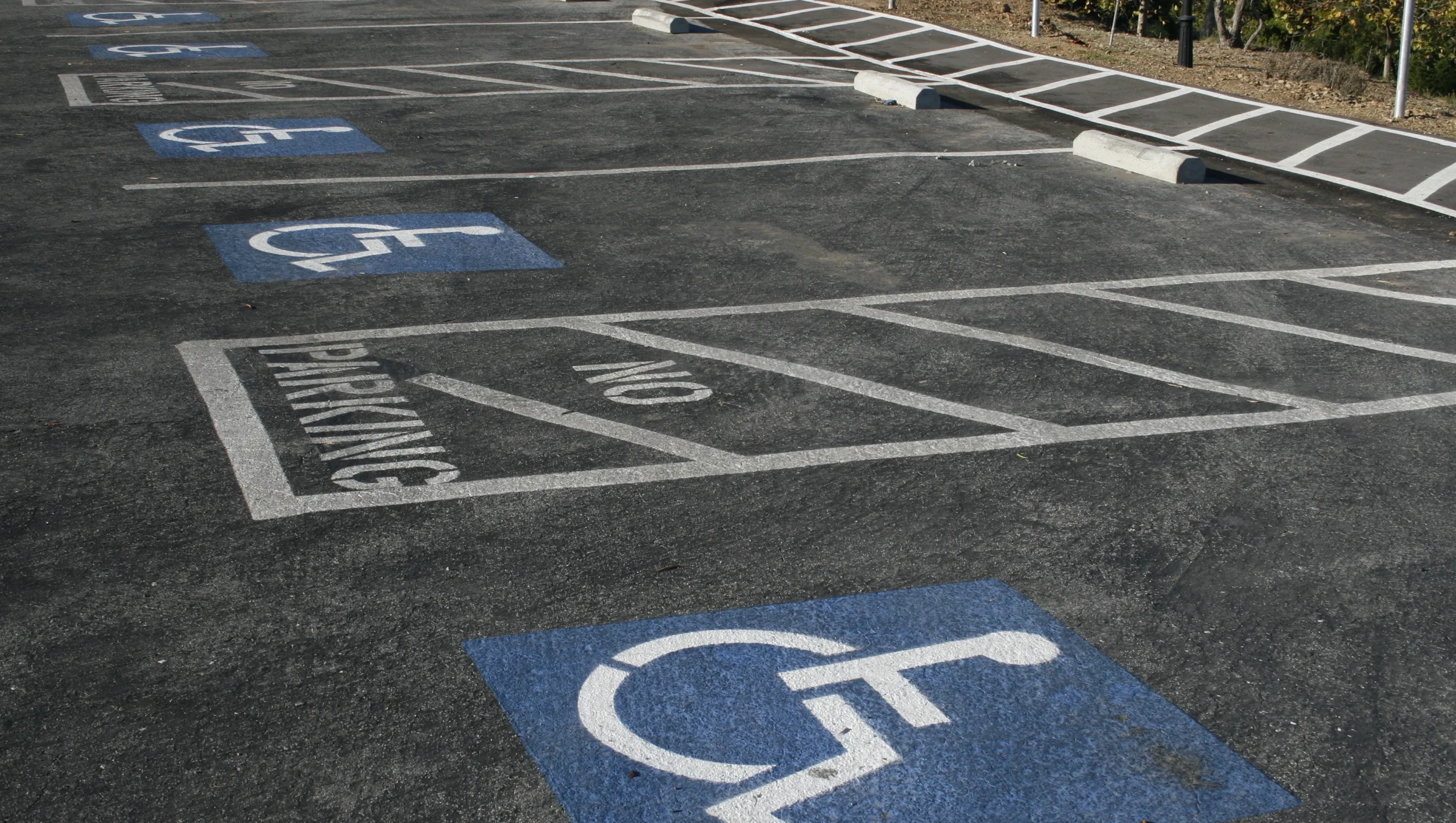The American Disabilities Act (ADA) was passed in 1990 to ensure that all Americans have equal access and opportunities, including Americans with any type of disability. ADA compliance requirements include parking lot features, and new or renovated parking lots must pass an ADA compliance check.
ADA compliance is a national standard and does not include codes that may be specific to your state or town. This means your new parking lot could meet national standards and still fail to meet state or municipal requirements. Today, we’re looking at national ADA requirements for parking lots.
Parking spaces
The ADA standards were updated in 2010, and the full text of the 2010 ADA Standards for Accessible Design can be found at ada.gov. For information on parking spaces, refer to Chapter 5- General Site and Building Spaces, Section 502: Parking Spaces.
The number of designated accessible parking spaces depends on the size of the parking lot and the total number of spaces. The ADA National Network website has a fact sheet with the number of required spaces under the Accessible Parking Fact Sheet. Download it for quick reference on all parking lot jobs.
- According to the fact sheet, a parking lot of up to 25 spaces only needs one accessible parking space, but that space must also be a van accessible space. A lot with 26 to 50 spaces needs two accessible spaces, with one of these van accessible. You can review the list for parking lots up to 1,000 spaces and beyond.
- This sheet also details requirements for medical facilities, which require more accessible spaces, and exceptions to these requirements, including parking lots exclusively used for buses and delivery trucks.
- An accessible parking space must be 96 inches wide (minimum) or 132 inches wide for van accessibility. These spaces must have an adjacent access aisle of 60 inches (minimum) extending the parking space’s full length.
- One in every six accessible spaces should also be van accessible. Angled van accessible spaces should have an access aisle on the passenger side. Access aisles should connect to an accessible path that is clear of any obstructions.
Accessible Aisles and Paths
Part of ADA compliance when constructing or restriping a parking lot is ensuring accessible aisles and paths. The ADA has strict specifications for these aisles and paths.
- Accessible parking must be clearly marked by signs and a recognized accessible symbol.
- Access aisles should be painted to discourage the use of the aisles as parking spaces.
- Accessible parking and access aisles and walkways should be built on the most level ground possible. The slope must be no greater than 1:48 inches for accessible parking spaces.
- Don’t forget anti-slip paint when painting the access aisles and walkways. Diagonal stripes are commonly used to denote accessible aisles and walkways.
Striping
Speaking of paint, let’s look at how to stripe accessible spaces in a parking lot. Even though the ADA standards are over 30 years old, there is still some confusion when it comes to striping these spaces.
The ADA recognized this and created a handy ADA Compliance Brief: Restriping Parking Spaces.
- Paint for accessible parking spaces and walkways must be a contrasting color from the paint used to stripe the rest of the parking spaces. Commonly used colors are blue and white. Check to see if your city or state mandates a color for accessible spaces.
- The international symbol of access is often included inside accessible parking spaces. This is not mandated federally but check with local or state guidelines.
- A sign marking the space as accessible is required. Post one sign for each accessible space.
- Non-accessible parking spaces are striped in a color contrasting the accessible spaces. If blue or white is used for accessible spaces, yellow can be used for other striping.
Asphalt Pro magazine has an informative article on ADA striping called How to Stripe ADA Compliant Parking Lots.
Curb Ramp Requirements
Our final section on ADA parking lot requirements is on curb ramp requirements. These requirements are listed in Chapter 4 (Accessible Routes) Section 406 in the 2010 ADA Standards for Accessible Design. The specifications are:
- Counter slopes should be no greater than 1:20 inches for connecting surfaces.
- The maximum slope of the sides of the curb ramp should be no greater than 1:10 inches.
- Landings are required at the top of every curb ramp, with a minimum length of 36 inches and a width matching the curb ramp.
- It is recommended that the curb ramp be painted a visible color and that reflective paint or tape be added to the edges for visibility.
- Curb ramps should not stick out into accessible aisles, parking spaces, or traffic lanes.
Though ADA parking lot requirements take a little extra time, they ensure everyone can access the parking lot safely and easily. It’s a job worth doing right and hitting each requirement for the sake of inspections and for those who use and appreciate the accessible features.
We would like to thank Jeff Gau, at St. Louis Paving, for suggesting this article topic.
